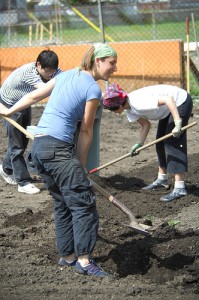 International collaboration works. I saw it in the Philippines, where I spent the better part of the last two months working for a Canadian not-for-profit (CESO). I blogged about it (e.g., 27 ways Filipinos create successful, collaborative e-Governance projects). I went half way around the world to collaborate with others. Now, I want to bring the world home!
International collaboration works. I saw it in the Philippines, where I spent the better part of the last two months working for a Canadian not-for-profit (CESO). I blogged about it (e.g., 27 ways Filipinos create successful, collaborative e-Governance projects). I went half way around the world to collaborate with others. Now, I want to bring the world home!
The Challenge
Make your neighbourhood a better place. I think my neighbourhood is a great place already. Yet, ever looking forward, my neighbourhood association’s stated mission is to improve and enhance the liveability, economic and social health of the neighbourhood. One of the ways we think we can do this is by increasing and sharing local food production. To accomplish that, we now have the luxury of collaborating and learning with others, from around the world, without even leaving our neighbourhood!Here’s why I think this type of international collaboration is an exciting prospect, and how we can practice it
Why bring the world to your neighbourhood?
- To get inspired by other people, ideas, and initiatives; e.g., Worldchanging: Bright Green
- To discover alternatives; new ways of thinking and doing; especially low-cost options that still provide value; e.g., Incredible Edible Todmorden
- To connect and share experiences and insights; get answers to the questions; e.g., how can we do this?
- To take the pressure off; working together with people having common concerns and interests is about gaining strength from the group, and reducing reliance on self; it’s connecting to grow
- To nurture and grow new skills and capacities, both individually and as a community
- To impress others (funding agencies?) with your initiative and innovation
- To make a difference
How to bring the (virtual) world to your neighbourhood
Unless your financial resources are deep (and can fly folks in), you’re going to bring the world to your neighbourhood through virtual means. Here’s a few ways how:
- Set up a website; make it interactive; invite input
- Blog about what you’re doing invite others to subscribe and/or participate in the conversation
- Listen to the conversations taking place on popular social networking sites; e.g., Facebook, Twitter, LinkedIn
- Join the conversations and/or set-up your own channels; e.g., Facebook group, Twitter hashtag, LinkedIn discussion group
- Use online meeting tools to talk/view with others; Skype, GoToMeeting
- Put your video on YouTube (or similar); annotate; invite viewers into your world
- Set up a public wiki; insert community information; invite comment
- Subscribe to web-based computing services; make it easy for the world to connect with you ; e.g., Google Earth
- Use web-based applications to canvas the world (or just your own community) for ideas and views; e.g., UserView
- Build your own web applications, using remote developers; e.g.; Odesk
And do this while maintaining stewardship over the process, and using low-cost and/or open source solutions? Yes, you can!
More to consider
The online channels now available are just new ways for us to connect and engage with other; i.e., be in relation to each other. And so, like face-to-face collaboration, virtual collaboration works when we are in good relationship with one another. I think that’s a good thing to keep in mind.
Got a great idea for your neighbourhood? What is it and how can the world help?
If you enjoyed this post, I would appreciate if you left a comment or subscribed to my blog. Your feedback helps me make this blog more interesting and relevant. Thanks, Ben.
Photo credit: itzafineday

Speak Your Mind